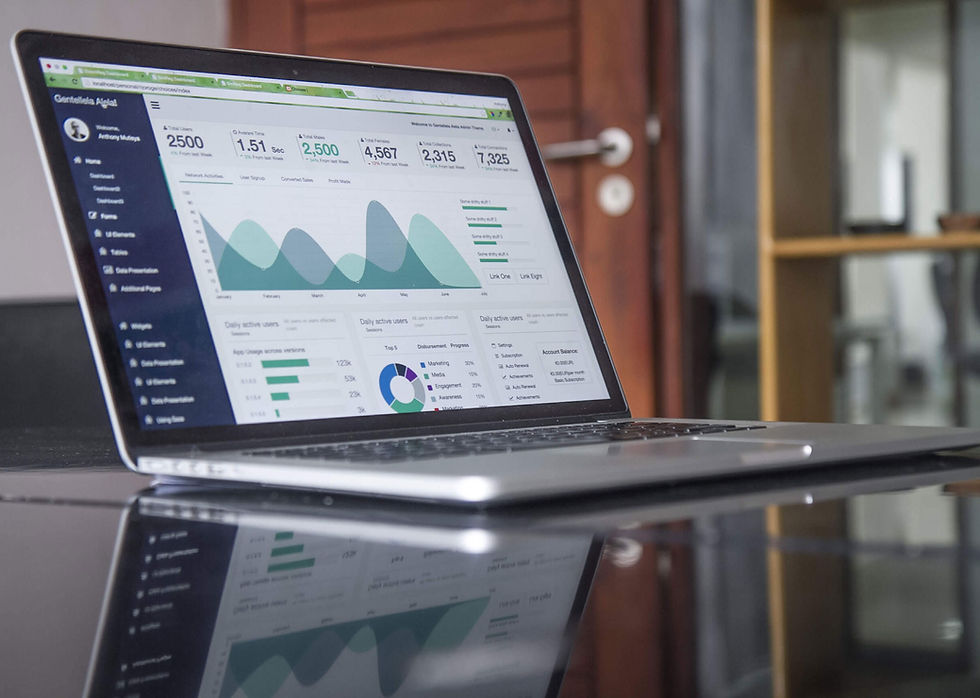The Impact of Targeted Paid Advertising on Business Growth
- The Social Sharks

- May 21, 2024
- 6 min read
Updated: Sep 24, 2024
In an era dominated by digital transformation, understanding the power of Google Ads and the broader scope of targeted paid advertising has become essential for businesses aiming to thrive. The impact of targeted paid advertising on business growth is profound, offering an unparalleled opportunity to connect with key demographics with pinpoint accuracy. By harnessing these advanced digital tools, companies are reaching their ideal customers more effectively and seeing significant ROI and brand engagement improvements.
What is Targeted Paid Advertising?
Targeted paid advertising refers to online advertising that allows brands to pinpoint their audience with incredible precision. Through platforms like Google Ads, Facebook, LinkedIn, and Instagram, businesses can display their marketing messages directly to consumers based on specific demographic details, interests, and buying behaviors. This strategy ensures that the advertising budget is spent on potential customers who are most likely to convert, making each ad dollar more effective.
The beauty of targeted advertising lies in its versatility across different platforms. Google Ads harness the power of search intent, Facebook and Instagram offer deep insights into user interests, and LinkedIn targets professional traits. Advertisers use a mix of keywords, user profiles, and retargeting tools to reach their audience. Retargeting, or remarketing, is particularly powerful as it reconnects businesses with users who have previously interacted with them, increasing the chances of conversion.
The Role of Data in Targeted Advertising
Data is the lifeblood of targeted advertising. Modern marketers harness vast amounts of data to understand consumer behavior and refine advertising strategies. This detailed data analysis enables advertisers to craft personalized messages that resonate with specific groups. Let’s take moving companies as an example. They’re most likely to target individuals in the process of relocating, offering timely advertisements that will likely result in lead generation, engagement, and conversion.
Businesses can optimize their ad placements by strategically using data to maximize reach and relevance. This approach enhances the efficiency of advertising efforts and significantly reduces wasted expenditures. It ensures business use their marketing budgets to impact the most promising prospects.
Benefits of Targeted Paid Advertising
The impact of targeted paid advertising on business growth is wide and multi-dimensional. By precisely reaching specific consumer segments, businesses can dramatically enhance the effectiveness of their marketing efforts. Here are the main benefits of this type of advertising.
Driving High Conversion Rates
The direct approach of targeted advertising often results in higher conversion rates. By addressing an audience's specific needs and wants, businesses can craft offers that are more likely to elicit a positive response. This precision reduces waste in advertising spend and improves the overall return on investment (ROI).
Enhancing Brand Visibility
Targeted ads do not just reach more people; they reach the right people. This tailored approach boosts brand visibility among those most likely to be interested in what a business offers, thereby enhancing brand recall and customer loyalty.
Cost Efficiency and Flexibility
Unlike traditional media, targeted digital ads offer unmatched flexibility in budgeting and scalability. Businesses can start small, test which ads perform best, and then scale up their spending based on concrete results. This method allows for meticulous budget control and ROI tracking.
Customer Engagement
Businesses foster greater engagement by delivering content that aligns with the interests and needs of a target audience. This personalized interaction builds trust and loyalty, which are critical to long-term business success.
Common Challenges and Solutions in Targeted Advertising
Targeted advertising, while highly effective, comes with its set of challenges. One of the common marketing mistakes business owners make is not refreshing ad content, which can lead to ad fatigue. Consumers who see the same ad too many times tune out, reducing the effectiveness of campaigns. Additionally, with increasing privacy regulations, advertisers must adapt to a tighter regulatory environment without compromising ad personalization and effectiveness.
However, even the most difficult challenges have solutions. For instance, regularly update ads with fresh content and creative designs to combat ad fatigue. Also, stay informed and compliant with data privacy laws, employing transparent data practices. Lastly, continuously analyze ad performance data to ensure content remains relevant to the target audience.
Best Practices for Implementing Targeted Paid Advertising
Implementing targeted paid advertising requires a strategic approach. Here are some best practices to help ensure your paid advertising efforts are as effective and efficient as possible.
1. Precision in Keyword Strategy
An effective paid advertising campaign begins with meticulous keyword research. Identifying high-intent keywords your target audience is searching for is crucial. It involves basic searches and exploring industry-specific terms and consumer behaviors that align with your business offerings.
Having a well-thought-out keyword strategy is imperative in service industries where understanding customer needs and search habits is key, such as the moving industry. Targeting keywords that potential customers are likely to use when they are ready to move, such as "best moving rates" or "reliable movers," is an example of a great strategy. This is especially important when it comes to PPC for moving companies because customers often search for moving services on short notice and are ready to make quick decisions. Effective keyword targeting ensures your ads reach potential customers at the right moment, increasing the chances of conversion and maximizing the return on your advertising spend.
2. Compelling and Consistent Ad Copy
The consistency between your ad copy and landing pages cannot be overstated. It ensures a seamless user experience and reinforces trust. Craft your ad headlines and descriptions to be both persuasive and informative, highlighting unique selling points and including strong calls-to-action (CTA). Regularly test different versions of your ad copy through A/B testing to identify what resonates best with your audience.
3. Optimizing Landing Pages for Conversion
Your landing pages are where potential leads convert into customers. Therefore, designing these pages to be visually appealing, quick to load, and easy to navigate is essential. To ensure your landing pages effectively convert visitors into clients, they should be user-friendly, load quickly, and align closely with the content and keywords used in your PPC campaigns.
If we look at landing pages through the lens of movers, they should communicate the services offered, such as local or long-distance moves, packing services, and storage solutions. Visual elements like high-quality images of packed moving trucks or video testimonials from satisfied customers can significantly enhance trust and engagement. Lastly, a clear and prominent call-to-action (CTA) such as "Get a Free Quote Today!" should be visible without scrolling, urging visitors to take immediate action. Combining these elements will give you a perfect landing page for any business.
4. Leveraging Technology and Analytics
In today’s tech-driven marketing environment, using advanced analytics and automation tools can greatly enhance the effectiveness of your campaigns. Tools like Google’s Automated Bidding or Conversion Optimizer can manage your bids in real time, maximizing your ROI.
Additionally, embracing AI and machine learning technologies can help predict customer behavior and optimize ad targeting and bidding strategies. Constant monitoring and adjusting based on analytics will keep your campaigns fresh and competitive.
Future Trends in Targeted Paid Advertising
As we look ahead, advances in artificial intelligence and machine learning are set to revolutionize the future of targeted paid advertising. These technologies will further refine the accuracy of ad targeting, making predictions more precise and campaign adjustments more effective in real time. In addition, integrating augmented reality in ads is expected to transform how brands engage with consumers, offering more immersive and interactive ad experiences.
Therefore, embracing these digital marketing strategies will be crucial to grow your business. They will provide the tools to reach potential customers more effectively and offer innovative ways to stand out in an increasingly crowded digital marketplace. The evolution of targeted advertising is poised to offer more dynamic and cost-effective solutions for sustainable business growth.
The Bottom Line of the Impact of Targeted Paid Advertising on Business Growth
The impact of targeted paid advertising on business growth is clear and undeniable. Focusing on specific demographics allows businesses to drive higher engagement, improve conversions, and ultimately achieve substantial growth. This strategic approach allows companies to maximize their advertising spend and gain significant competitive advantages in their respective markets. Embracing these advanced advertising techniques is no longer just an option but a necessity for any business looking to succeed in the digital age.














slot gacor, slot qris, slot qris, slot qris, slot gacor, game online, slot gacor,
bos288, slot gacor, bos288, login bos288, slot dana, bos288, bos288,
link slot, raja168, slot gacor, raja168, slot, slot gacor, slot, raja168, raja168,
slot gacor, raja168, raja168, slot deposit dana, raja168, situs toto, situs slot gacor,
raja slot, situs toto, slot deposit qris, slot gacor, slot gacor, raja168, slot, raja168, slot dana,